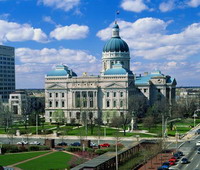Login form
Indiana

Indiana’s nickname is the Hoosier State. That’s why people from Indiana, or Indianians, are also sometimes called Hoosiers. No one is sure where the name comes from. One story says that Indiana pioneers asked, “Who’s yere?” when someone knocked on their doors. From this question, Indiana supposedly became known as the Whosyere or Hoosier State.
THE HOOSIER STATE
Indiana is mostly flat. Only the southern portion near the Ohio River is hilly. The state was once heavily forested, but most of the trees were cleared for farmland. Today, corn is Indiana’s leading crop.
Settlers and fur trappers from France were the first Europeans to live in Indiana. They arrived in the early 1700s and built forts and trading posts. Vincennes was the most important French settlement in Indiana.
The Congress of the United States created the Indiana Territory in 1800. Vincennes became the capital of the Indiana Territory. On December 11, 1816, Indiana became the 19th state to join the United States. The capital moved to Indianapolis in 1824.
CROSSROADS OF AMERICA
Indiana is sometimes called the Crossroads of America. That’s because a lot of transportation networks pass through the state. It’s on a number of main railroad lines. Four interstate highways go through Indianapolis, the capital.
Until about 1850, rivers were the main routes for moving goods in and out of Indiana. The Ohio River was the chief transportation route. It is still important for shipping the state’s goods.
LAND OF THE INDIANS
The name Indiana means “the land of Indians.” It was Indian land when the first white settlers arrived in the late 1700s and early 1800s. Native Americans who lived in Indiana included the Miami, Wea, Kickapoo, Shawnee, and Delaware. Some of these groups had already been pushed off their land to the East. By 1838, few Native Americans were left in Indiana. White settlers had forced them to move farther west.
The Indiana Territory, created in 1800, included Illinois, Michigan, Wisconsin, and part of Minnesota, in addition to Indiana. The governor of the Indiana Territory from 1800 to 1812 was William Henry Harrison, who later became the ninth president of the United States. You can visit the home he built, called Grouseland, in Vincennes.
TECUMSEH AND TIPPECANOE
Native Americans who hoped to regain their lands banded together. Their leaders were Shawnee chief Tecumseh and his brother, known as the Shawnee Prophet. In 1811, a battle took place near the Tippecanoe River between the Shawnee and troops from the Indiana Territory led by Harrison.
Harrison’s forces won the Battle of Tippecanoe. Afterward, Harrison was nicknamed Old Tippecanoe. The victory broke Tecumseh’s power and made Harrison a hero to many Americans.
In 1840, Old Tippecanoe was elected president of the United States. But he died of pneumonia only a month after taking office.
INDIANAPOLIS
Indianapolis is the state’s largest city. In 1820, a government committee chose the location for Indiana’s new capital—the geographic center of the state. The government also chose the name Indianapolis. It means “City of Indiana,” using the Greek word polis for “city.”
INDIANAPOLIS 500
The biggest sports event in Indiana is the Indianapolis 500, a 500-mile (805-kilometer) automobile race held at the Indianapolis Motor Speedway. The first Indy 500 was held in 1911. The winning driver’s average speed that year was 74.6 miles per hour (120 kilometers per hour). Today, drivers reach speeds of 240 miles per hour (386 kilometers per hour). The race takes place every year on the Sunday of Memorial Day weekend. At the Indianapolis Motor Speedway Hall of Fame, you can see the car that won the 1911 race, and you can ride around the track on a bus.
BEACHES, CAVES, AND PARKS
Indiana has beaches? Yes! It has the Indiana Dunes National Lakeshore along Lake Michigan. The area consists of sand dunes, beaches, and marshland. It’s one of many recreational lands in Indiana.
In Southern Indiana you can visit Wyandotte Cave. It’s one of the largest limestone caves in the country and has about 35 miles (about 56 kilometers) of passages!
Indiana’s state parks are popular for hiking, horseback riding, camping, fishing, and other outdoor activities. Brown County State Park is in rolling hills in south central Indiana. It’s noted for its scenic beauty, especially in autumn when the leaves turn spectacular colors. Turkey Run State Park in west central Indiana has rugged sandstone canyons, winding streams, and lots of wildlife.
COVERED BRIDGES
Parke County, Indiana, boasts that it has more covered bridges than any other county in the United States. In October, it holds a festival to showcase its 32 covered bridges, but visitors can tour them at any time of year.
Why were wooden bridges of the 1800s covered with roofs? You might expect the purpose was to protect people crossing the bridge from rain and snow. But the purpose was to protect the wooden bridge and its supports from getting wet and rotting.
Source: Microsoft ® Encarta

